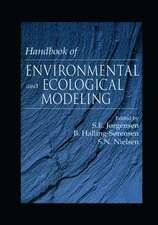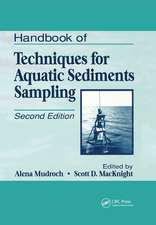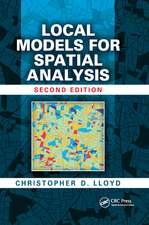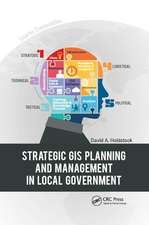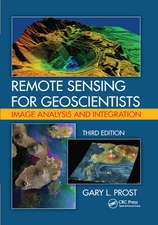Handbook of Ecological Models used in Ecosystem and Environmental Management: Applied Ecology and Environmental Management
Editat de Sven Erik Jorgensenen Limba Engleză Hardback – 11 apr 2011
Published first in 1996, Handbook of Models Applied in Ecosystem and Environmental Management applies precisely this approach to review current models applied in ecosystem-wide as well as environmentally specific management. Divided into two sections, the first section focuses on models of common ecosystems, leaving out only the most rare and extreme. Chapters cover coastal and marine ecosystems, wetlands, and estuaries; lake models and those general considerations valid for all freshwater ecosystems; grasslands, forests, and general features of terrestrial ecosystems; and managed ecosystems including agriculture and aquaculture as well as wastewater treatment systems.
Section II devotes attention to specific environmental problems. It begins with a look at "out of balance" problems such as eutrophication models, models of oxygen depletion, and acidification models in water pollution. Further chapters cover pollution by toxic substances, namely, heavy metal and organic toxins; global warming; fire and the spread of fire, and air pollution and the unique considerations of aerodynamics.
Supported with extensive references, Handbook of Models Applied in Ecosystem and Environmental Management provides a solid overview of the models currently in use for the management and homeostasis of whole ecosystems as well as for the solution of today’s most pressing environmental problems.
| Toate formatele și edițiile | Preț | Express |
|---|---|---|
| Paperback (1) | 427.16 lei 6-8 săpt. | |
| CRC Press – 16 dec 2019 | 427.16 lei 6-8 săpt. | |
| Hardback (1) | 1128.91 lei 6-8 săpt. | |
| CRC Press – 11 apr 2011 | 1128.91 lei 6-8 săpt. |
Din seria Applied Ecology and Environmental Management
- 18%
 Preț: 1299.23 lei
Preț: 1299.23 lei - 15%
 Preț: 585.27 lei
Preț: 585.27 lei - 15%
 Preț: 461.03 lei
Preț: 461.03 lei - 22%
 Preț: 329.91 lei
Preț: 329.91 lei -
 Preț: 445.99 lei
Preț: 445.99 lei - 15%
 Preț: 427.16 lei
Preț: 427.16 lei - 12%
 Preț: 343.91 lei
Preț: 343.91 lei - 13%
 Preț: 297.05 lei
Preț: 297.05 lei - 25%
 Preț: 3753.12 lei
Preț: 3753.12 lei - 27%
 Preț: 380.05 lei
Preț: 380.05 lei - 13%
 Preț: 315.29 lei
Preț: 315.29 lei - 15%
 Preț: 585.27 lei
Preț: 585.27 lei -
 Preț: 471.47 lei
Preț: 471.47 lei -
 Preț: 436.14 lei
Preț: 436.14 lei - 18%
 Preț: 1120.23 lei
Preț: 1120.23 lei - 15%
 Preț: 697.38 lei
Preț: 697.38 lei
Preț: 1128.91 lei
Preț vechi: 1376.72 lei
-18% Nou
Puncte Express: 1693
Preț estimativ în valută:
216.01€ • 225.54$ • 178.78£
216.01€ • 225.54$ • 178.78£
Carte tipărită la comandă
Livrare economică 05-19 aprilie
Preluare comenzi: 021 569.72.76
Specificații
ISBN-13: 9781439818121
ISBN-10: 1439818126
Pagini: 636
Ilustrații: 134 b/w images, 54 tables and at least 288 equations
Dimensiuni: 156 x 234 x 38 mm
Greutate: 1.02 kg
Ediția:Revised
Editura: CRC Press
Colecția CRC Press
Seria Applied Ecology and Environmental Management
ISBN-10: 1439818126
Pagini: 636
Ilustrații: 134 b/w images, 54 tables and at least 288 equations
Dimensiuni: 156 x 234 x 38 mm
Greutate: 1.02 kg
Ediția:Revised
Editura: CRC Press
Colecția CRC Press
Seria Applied Ecology and Environmental Management
Public țintă
Researchers and graduate students in ecology and applied ecology; managers and consultants dealing with environmental problems; and anyone using ecological models in research and environmental management.Cuprins
ECOSYSTEM MODELS: Lakes. Estuaries. Rivers. Coastal zones (Fjords, bays etc.). Lagoons. Grassland. Agricultural systems. Wetlands. Forests. Savanna. Natural Parks. The Atmosphere. Polar ecosystems. Mountain ecosystems. Aquaculture systems. Waste Water Systems. ENVIRONMENTAL MANAGEMENT PROBLEMS: Oxygen depletion. Eutrophication. Acid rain. Organic toxic substances. Heavy metals. Medicine in the environment. Landscape Planning. Fishery. Species diversity and alien species. The ozone layer. Global warming. Ground water pollution. State-of-the-art of the Use of Models in Environmental Management.
Notă biografică
Sven Erik Jørgensen works with the Royal Danish School of Pharmacy.
Descriere
Written to help researchers and environmental managers tackle environmental problems, this book presents models as reference points for specific plans of action. The first part of the book focuses on the type of ecosystem, while the second focuses on the different types of environmental problems. The author explains which models to use in particular situations. Areas covered include lakes, estuaries, and rivers. Environmental problems covered include oxygen depletion, species diversity, and ground water pollution. The book includes many tables and figures throughout.






